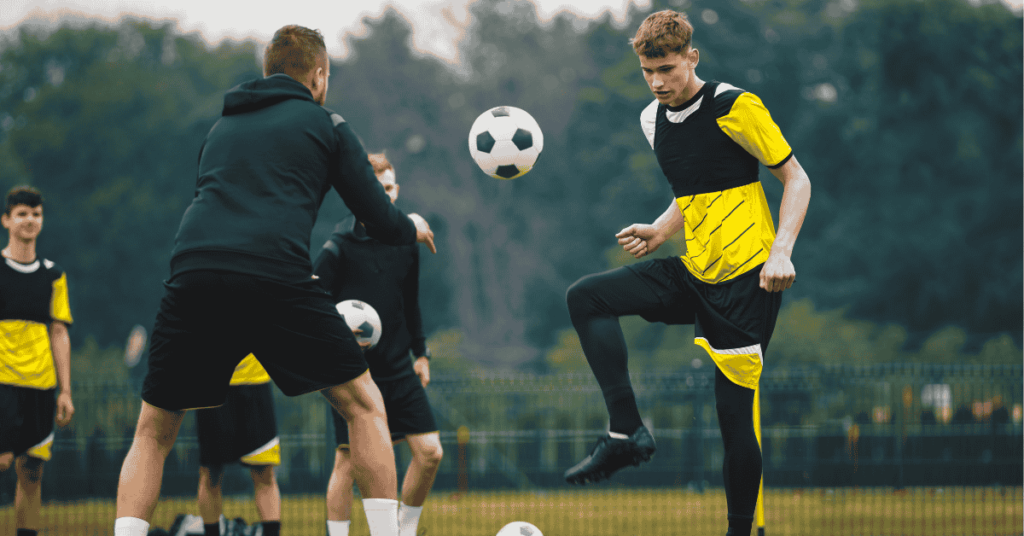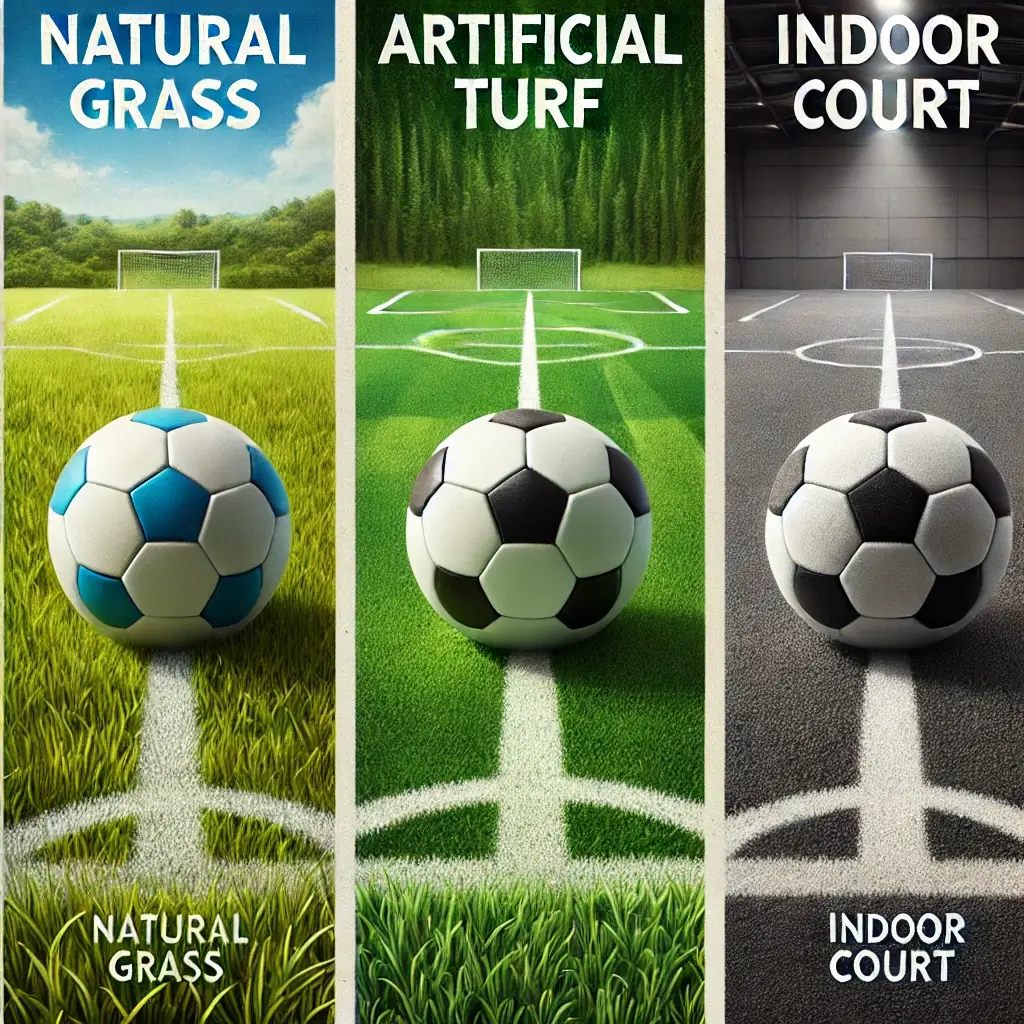Why Your Soccer Training Ball Choice Impact Your Game?
A training soccer ball is more than just gear—it’s your partner in skill-building. Whether you’re dribbling through cones, perfecting free kicks, or coaching young players, the right training soccer ball ensures consistency, durability, and a realistic game-like feel. Let’s break down how to pick the perfect one, step by step.
Choosing the right soccer ball for training is crucial to develop your skills and enhance performance. A top-tier training soccer ball helps in mastering control, accuracy, and agility. It feels and performs like the match balls, ensuring that the training translates perfectly into the game.
Moreover, investing in a high-quality practice ball boosts the players’ confidence and lays the groundwork for advanced techniques. An experienced soccer player is one who uses the right tools , and the soccer ball is the most essential for the sport. Therefore, players from all levels need to use a soccer ball that enhances their learning experience, making every practice ball touch a worthwhile one.
How to Choose the Right Training Soccer Ball?

6 Key Factors to Consider for Choosing the Perfect Training Soccer Ball
1. Size: Match the Ball to the Player’s Age
The first thing to consider is size. The size of the ball is more critical than most players think. For example, size 5 soccer balls for training will work well for players older than 12 years. It is the standard size, ensuring no surprises when the player has to switch to the match conditions. For younger ones, the size 3 or 4 ball will better suit their developing skills and capabilities.
- Size 5 (Ages 12+): Official match size for teens and adults. Builds muscle memory for competitive play.
- Size 4 (Ages 8–12): Smaller and lighter for developing control and confidence.
- Size 3 (Under 8): Mini size for toddlers learning coordination.
Why It Matters: Using the wrong size can strain technique. A heavy size 5 ball might overwhelm a 10-year-old’s footwork.srt
2. Weight: Keep It Realistic
Another essential factor is the weight of the ball. When too heavy, the ball can restrict dribbling and passing it. When too light, it becomes less durable and might not transfer accurately. Therefore, the training ball should weigh the same as the matchday ball. The right training soccer ball caters to the players’ touch development and ensures the ball feels natural. Apart from making the right decisions while playing, the right weight of a ball promotes long-distance kicking.
- Ideal Weight: 14–16 ounces (same as match balls).
- Too Heavy: Slows down dribbling and passing.
- Too Light: Feels “floaty” and reduces shooting accuracy.
Pro Tip: Look for FIFA Quality Pro or IMS certification to ensure standard weight.
3. Material: Balance Durability and Feel
A practice ball should have impeccable durability. If a soccer ball offered for training rips after several uses, it is not worth buying. An ideally suitable material for football balls is Synthetic leather. It often includes high-performance materials such as PU or thermoplastic polyurethane. The most important thing to consider is that the ball should stay in shape and function properly throughout the practice. In that way, players will gain the best possible experience and enhance their skills. Therefore, choose a ball made from durable material, ensuring it will not rupture in half during the next power shot you attempt.
- PU (Polyurethane): Soft touch, water-resistant, and long-lasting. Best for grass/turf.
- PVC: Affordable but stiff and less durable. Good for casual use.
- TPU (Thermoplastic Polyurethane): Mid-range durability with decent grip.
Stitching:
- Hand-Stitched: Durable and maintains shape.
- Thermally Bonded: Seamless surface for consistent flight.
4. Inflation: The Goldilocks Zone
Finally, do not forget the inflation level; qualified training soccer balls offer better performance and accuracy while passing or shooting when they are far better inflated than the ones we use at the beach.
- Optimal PSI: 8.5–15.6 (check the ball’s printed recommendation).
- Overinflated: Unpredictable bounces and hard on the feet.
- Underinflated: Sluggish movement and poor passing response.
Use a Pump with a Gauge: Beach pumps often overinflate!
5. Surface-Specific Design

- Grass/Turf: Textured panels for better grip.
- Indoor: Rubber or foam core to reduce bounce.
- Concrete/Asphalt: Reinforced outer layers to resist abrasion.
6. Training vs. Match Balls: Know the Difference
| Feature | Training Ball | Match Ball |
|---|---|---|
| Durability | Built for daily rough use | Optimized for speed and precision |
| Cost | Budget-friendly (20–20–50) | Premium (100–100–200) |
| Use Case | Repetitive drills, skill-building | Competitive matches |
Maintenance Tips to Extend Lifespan of Soccer Training Balls
- Store Indoors: Sun and rain warp the material.
- Rotate Balls: Alternate between two to reduce wear.
- Avoid Concrete Surfaces: Opt for grass or turf to minimize abrasion.
Final Thoughts: Practice Smarter, Not Harder
Choosing the right training soccer ball isn’t about finding the “best” one—it’s about matching your needs. Prioritize size, material, and surface compatibility to make every practice session count. Whether you’re a player grinding drills or a parent supporting a young athlete, the right ball turns effort into progress.
Ready to level up? Grab your ball, hit the field, and let your skills do the talking!
Top Questions from Players & Parents Answered
1. What is a Training Soccer Ball?
A training soccer ball is a durable ball designed for practice sessions. Made from synthetic leather or PU materials, it withstands repeated use while maintaining consistent performance.
2. What’s the Difference Between a Training Ball and a Match Ball?
Training balls are built for durability and cost-effectiveness, ideal for daily practice. Match balls are premium-grade, designed for optimal performance in competitive games.
3. Which Size Training Soccer Ball Should I Choose?
- Size 5: For players aged 12 and above (standard match size).
- Size 4: For ages 8–12 (lighter and smaller for developing skills).
- Size 3: For players under 8 (perfect for toddlers).
4. What is a Pitch Training Soccer Ball?
A pitch training soccer ball is designed for ground practice, focusing on improving footwork, ground control, and passing accuracy.
5. What’s the Best Use of an Adidas MLS Training Soccer Ball?
The Adidas MLS training soccer ball is ideal for skill development and consistent performance across different playing surfaces.
6. Can I Use a Training Ball in Official Matches?
Technically yes, but match balls offer better precision. Most leagues require FIFA-certified balls for official games.
7. How Do I Know If My Soccer Ball is the Right Size?
Stand over the ball—it should reach just below your knee. For kids, follow age guidelines (Size 3, 4, or 5).
8. How Often Should I Inflate My Training Ball?
Check the pressure weekly. Soccer balls naturally lose 1–2 PSI over time.
9. Why Does My Ball Lose Shape Quickly?
Low-quality materials or improper storage can cause this. Avoid leaving the ball in extreme heat or cold.
10. What’s the Best Training Ball for Wet Weather?
Choose water-resistant PU with micro-textured panels for better grip in wet conditions.
11. Are Expensive Training Balls Worth It?
Not always! Mid-range balls (30–30–50) from trusted brands often balance cost and durability.
12. How Do I Clean My Soccer Ball?
Wipe it with a damp cloth and mild soap. Never submerge the ball in water.
13. Why Does My Ball Feel Too Hard?
It’s likely overinflated. Release air until it meets the recommended PSI (8.5–15.6).
14. Can a Training Ball Improve My Shooting Accuracy?
Yes! Consistent weight and feel help build muscle memory, improving accuracy over time.
15. Can I Use a Match Ball for Training?
It’s not ideal—match balls wear out faster and cost more to replace.
16. How Often Should I Replace My Training Ball?
Every 6–12 months, depending on usage. Look for fading panels or loss of shape as signs of wear.
17. What’s the Best Training Ball for Beginners?
A Size 4 or 5 ball with PU material and good cushioning is ideal for beginners.
18. How Do I Store My Soccer Ball Properly?
Store it indoors, away from extreme heat or cold, to maintain its shape and durability.
19. What’s the Difference Between PU and PVC Soccer Balls?
- PU: Soft, durable, and water-resistant. Ideal for grass/turf.
- PVC: Stiff and less durable. Best for casual use or indoor surfaces.
20. Can I Use a Training Ball on Concrete?
Yes, but choose a ball with reinforced outer layers to resist abrasion.


